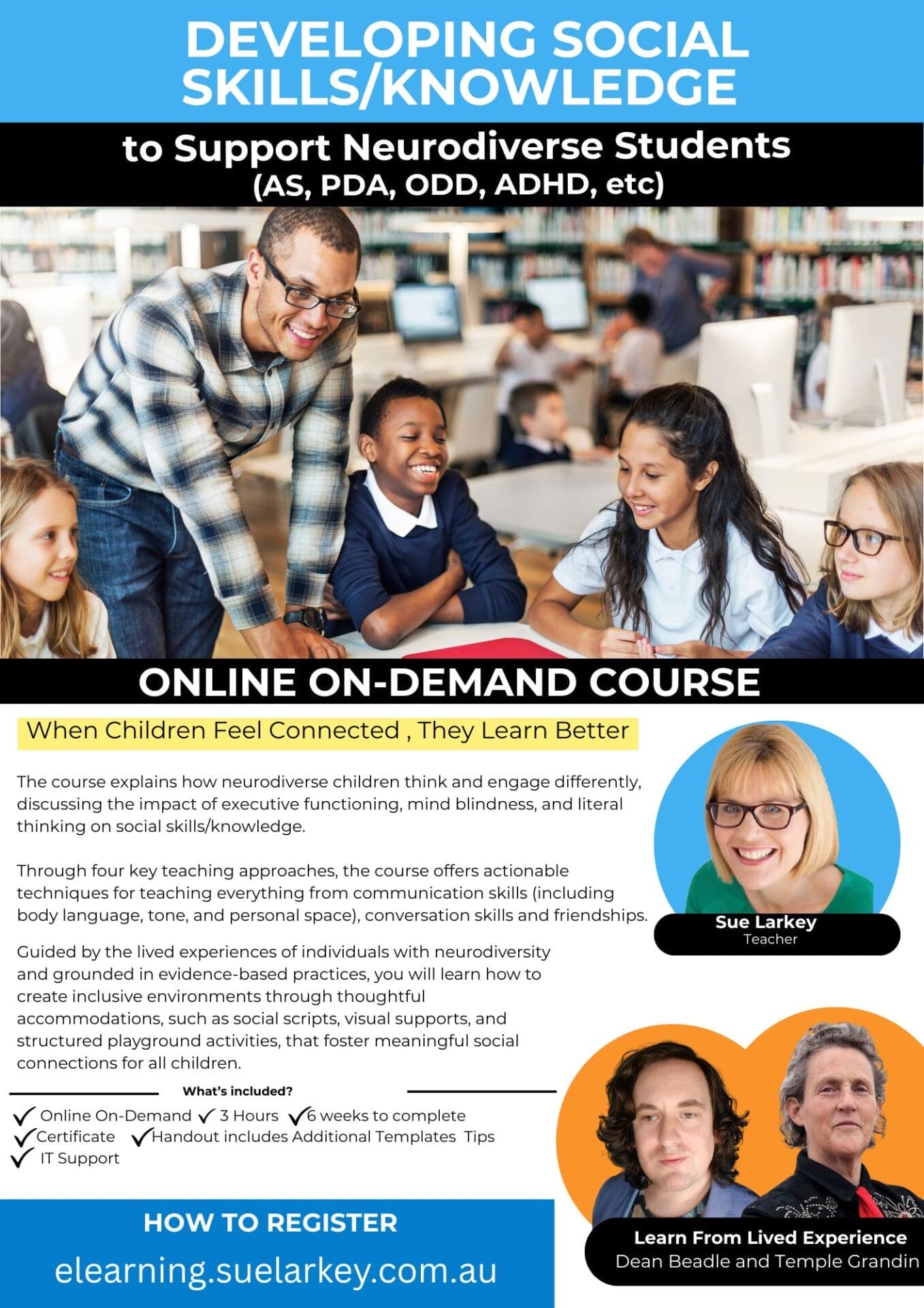Webinar replay – 13 key strategies for setting up your classroom
Discover 13 Strategies for Setting up your Classroom Today!
My Live Webinar last week was a success! But it’s not too late – sign up HERE to watch the Replay of the hour of power!
FREE sign up includes:
🎆 E-book
🎆 Webinar Replay
🎆 Handout
What will you learn in the Webinar?
- 10:00 – Number 1 Question I ask myself when I go into classrooms
- 27:38 – What Skills does sitting really require ? (Hint…… Not listening and Sitting Still)
- 38:10 – Top Tip to Try over the next week
- 54:00 – Recess & Lunch Breaks. Why we need different strategies
Learn 13 Strategies for Setting up your Classroom Today!
13 Key STRATEGIES FOR SETTING UP YOUR CLASSROOM
Excerpt from the free E-book Setting Up Your Classroom For Success by Sue Larkey
1. Position in Classroom
Seating, mat time, assembly, parades, etc.
Have a set position for the student which takes into account:
- Who they are next to
- Where in the room or group they are
- How close they are to the teacher
- Distractions
- Whether they are too close to favourite acitivies like books, computers, Lego, etc.
- Sensory distrations – noises, smells, lighting, objects hanging too close
- Some students prefer to be enar a door so they can leave if anxiety is building (particularly in secondary school)
2. Bags/Lockers/Tote Boxes
Ensure neurodiverse students are at the quiet end of the row. Students often don’t like being touched, feeling crowded or the noise that happens in the busy areas.
3. Writing
60% of students with ASD have dysgraphia. This means handwriting can be messy, slow or sometimes even avoided, especially as they get older. You may need to consider allowing iPads, computers and other forms of technology as their means of writing as the goal is that they do the work. In the younger years pencil grips can support handwriting skills.
4. Organisation
ASD students often find organisation of their school equipment very difficult. Limit the number of books, and equipment, perhaps set up system like colour coding to help with organisation.
5. Quiet Area
Ensure there is an area where the student can retreat to if they are feeling overwhelmed. This can be a quiet table, reading corner, outside the classroom in hallway, alcove, office, etc. Some students also need to be placed near a door in the classroom or assembly as they need a perceived escape route.
6. Teacher Assistant/Education Support Officers
Consider how best to use support time effectively in the first few weeks. You may need them to make additional support materials, schedules, visuals, social stories, organisation, etc. See Teacher Assistants Big Red Book of Ideas.
7. Schedules/Timetables/Timers
These are VITAL no matter what age. This may be in a range of formats such as photos, visuals or words. Using a Timer supports the schedule and allows students to know HOW LONG activities will take. Click here to buy timers.
8. Note Pad and Pen
Always carry a note book and pen for when things change – we tend to talk too much. These children are visual and if you can write it down or draw a picture it can stop behaviour escalating.
9. Reading
Be aware many students have hyperlexia where they can decipher written words but do not comprehend what they are reading.
10. Recess/Lunch
Make sure they know boundaries, days they are allowed on equipment, where to go if there’s a problem, safe places, when the library is open, clubs they can join, etc.
11. Toilet/Drink
Many students with ASD will not access these at the same time as other students. It is recommended you send them out during class time to the toilet and get a drink as this can impact on their learning. BE AWARE they may not ask you to go to the toilet – you will need to send them.
12. Sensory Tools
Many students require sensory tools to focus, process or calm. You will probably need to provide a range of sensory tools for the student. This may include a sensory mat to sit on, fidget tools, chewy necklaces, tubes or pencil toppers.
13. Eating
Because of their sensory processing difficulties some students find it hard to eat at appropriate times because the smells of other student’s food or even the sound of them eating many be overwhelming. You may need to allow them to eat separately from other students.
**Early Years**: please note the above considerations are also important for your setting. You may need to also consider structure for nap times and often you will encounter more sensory issues because of the type of activities the children are engaged in, for example more play and craft activities can mean more sensory activities.
Developing Social Skills to Support Neurodiverse Children
(AS, PDA, ODD, ADHD, etc)
✅ What, How & When to teach Social Skills
✅ Myths & Misunderstanding
✅ How to Make and Keep Friends
✅ Impact of Executive functioning
✅ 4 Steps to Create Social Skills Program
✅ Lived Experience of Social Learning
✅ Creating Inclusive Playground
AVAILABLE and ON SALE Now
 3 Hours
3 Hours
 Certificate
Certificate
$149






 Sorry we no longer ship items outside Australia. Please consider the digital versions of Sue’s Books –
Sorry we no longer ship items outside Australia. Please consider the digital versions of Sue’s Books – 